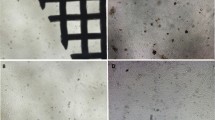Summary
Thirteen cell lines were established and characterized from brain, kidney, lung, spleen, heart, liver, gall bladder, urinary bladder, pancreas, testis, skin, and periorbital and tumor tissues of an immature male green turtle (Chelonia mydas) with fibropapillomas. Cell lines were optimally maintained at 30° C in RPMI 1640 medium supplemented with 10% fetal bovine serum. Propagation of the turtle cell lines was serum dependent, and plating efficiencies ranged from 13 to 37%. The cell lines, which have been subcultivated more than 20 times, had a doubling time of approximately 30 to 36 h. When tested for their sensitivity to several fish viruses, most of the cell lines were susceptible to a rhabdovirus, spring viremia carp virus, but refractory to channel catfish virus (a herpesvirus), infectious pancreatic necrosis virus (a birnavirus), and two other fish rhabdoviruses, infectious hematopoietic necrosis virus and viral hemorrhagic septicemia virus. During in vitro subcultivation, tumor-like cell aggregates appeared in cell lines derived from lungs, testis, and periorbital and tumor tissues, and small, naked intranuclear virus particles were detected by thin-section electron microscopy. These cell lines are currently being used in attempts to isolate the putative etiologic virus of green turtle fibropapilloma.
Similar content being viewed by others
References
Aguirre, A. A.; Spraker, T. R. Microscopic and ultrastructural evidence of herpesvirus-like virus in Hawaiian green turtles (Chelonia mydas) with fibropapillomatosis. Southwest Fisheries Center Administrative Report H-96-06C. NOAA, Honolulu; 1996:14 p.
Balazs, G. H. Current status of fibropapilloma in Hawaiian green turtle, Chelonia mydas. In: Balazs, G. H.; Pooley, S. G., ed. Research plan for marine turtle fibropapilloma. U.S. Department of Commerce, NOAA Tech. Memo, NOAA-TM-NMFS-SWFSC-156; 1991:47–57.
Balazs, G. H.; Aguirre, A. A.; Murakawa, S. K. K. Occurrence of oral fibropapillomas in the Hawaiian green turtle: differential disease expression. Marine Turtle Newsl. 76:1–2; 1997.
Brown, F. The family Rhabdoviridae, general description and taxonomy. In: Wagner, R. R., ed. The rhabdoviruses. New York: Plenum Press; 1987:1–8.
Bussereau, F.; De Kinkelin, P.; Le Berre, M. Infectivity of fish rhabdoviruses for Drosophila melanogaster. Ann. Microbiol. 126A:389–395; 1975.
Casey, R. N.; Quackenbush, S. L.; Work, T. M., et al. Evidence for retrovirus infections in green turtles Chelonia mydas from the Hawaiian Islands. Dis. Aquat. Org. 31:1–7; 1997.
Chen, Y. X.; Jiang, Y. L. Morphological and physiochemical characterization of reovirus from haemorrhage of grass carp [in Chinese]. Monthly J. Sci. 18:1138–1140; 1983.
Earley, E. M. Chromosome preparations from monolayer cell cultures. TCA Manual 1:31–35; 1975.
Freshney, R. I., ed. Culture of animal cells, a manual of basic technique. New York: Wiley-Liss; 1994:486 p.
Fryer, J. L.; McCain, B. B.; Leong, J. C. A cell line derived from rainbow trout (Salmo gairdneri) hepatoma. Fish Pathol. 15:193–200; 1981.
George, R. H. Health problems and diseases of sea turtles. In: Lutz, P. L.; Musick, J. A., ed. The biology of sea turtles. Boca Raton: CRC Press; 1997:363–385.
Groombridge, B.; Wright, L., ed. The IUCN Amphibia-Reptilia Red Data Book, Part I. IUCN, Gland, Switzerland; 1982:xviii.
Herbst, L. H.; Jacobson, E. R.; Moretti, R., et al. Experimental transmission of green turtle fibropapillomatosis using cell-free tumor extracts. Dis. Aquat. Org. 22:1–12; 1996.
Johnson, K. M.; Tesh, R. B.; Peralta, P. H. Epidemiology of vesicular stomatitis virus: some new data and a hypothesis for transmission of the Indiana serotype. J. Am. Vet. Med. Assoc. 155:2133–2140; 1969.
Jokiel, P. L.; Coles, S. L. Response of Hawaiian and other Indo-Pacific reef corals to elevated temperature. Coral Reefs 8:155–162; 1990.
Koment, R. W.; Haines, H. Characterization of a reptilian epithelioid skin cell line derived from the green turtle, Chelonia mydas. In Vitro 18:227–231; 1982.
Lannan, C. N.; Winton, J. R.; Fryer, J. L. Fish cell lines: establishment and characterization of nine cell lines from salmonids. In Vitro Cell. Dev. Biol. 20:671–676; 1984.
Lu, Y.; Lannan, C. N.; Rohovec, J. S., et al. Fish cell lines establishment and characterization of three new cell lines from grass carp (Ctenopharyngodon idella). In Vitro Cell. Dev. Biol. 26:275–279; 1990.
Lu, Y.; Nadala, E. C. B., Jr.; Brock, J. A.; Loh, P. C. A new virus isolate from infectious hypodermal and hematopoietic necrosis virus (IHHNV)-infected penaeid shrimps. J. Virol. Methods 31:189–196; 1991.
Mansell, J.; Jacobson, E. R.; Gaskin, J. M. Initiation and ultrastructure of a reptilian fibroblast cell line obtained from cutaneous fibropapillomas of the green turtle, Chelonia mydas. In Vitro Cell. Dev. Biol. 25:1062–1064; 1989.
Middlebrooks, B. L.; Ellender, R. D.; Wharton, J. H. Fish cell cultures: a new cell line from Cynoscion nebulosus. In Vitro Cell. Dev. Biol. 15:109–111; 1979.
Middlebrooks, B. L.; Mak, P. C.; Ellender, R. D. Properties of an established cell line from the Atlantic croaker (Micropogon undulatus). Proc. Soc. Exp. Biol. Med. 165:123–128; 1980.
Middlebrooks, B. L.; Stout, D. L.; Ellender, R. D. Fish cell lines: two new cell lines derived from explants of trunk musculature of Cynoscion arenarius. In Vitro Cell. Dev. Biol. 17:427–430; 1981.
Moore, M. K.; Work, T. M.; Balazs, G. H., et al. Preparation, cryopreservation and growth of cells prepared from the green turtle (Chelonia mydas). Methods Cell Sci. 19:161–168; 1997.
Quackenbush, S. L.; Work, T. M.; Balazs, G. H., et al. Three closely related herpesviruses are associated with fibropapillomatosis in marine turtles. Virology 246:392–399; 1998.
Wolf, K. Cold-blooded vertebrate cell and tissue culture. Methods in enzymology LVIII:466–477; 1979.
Work, T. M.; Balazs, G. H. Causes of green turtle (Chelonia mydas) morbidity and mortality in Hawaii. Proceedings of the Seventeenth Annual Symposium on Sea Turtle Biology and Conservation, Orlando (in press).
Author information
Authors and Affiliations
Rights and permissions
About this article
Cite this article
Lu, Y., Nerurkar, V.R., Aguirre, A.A. et al. Establishment and characterization of 13 cell lines from a green turtle (Chelonia mydas) with fibropapillomas. In Vitro Cell.Dev.Biol.-Animal 35, 389–393 (1999). https://doi.org/10.1007/s11626-999-0113-6
Received:
Accepted:
Issue Date:
DOI: https://doi.org/10.1007/s11626-999-0113-6




